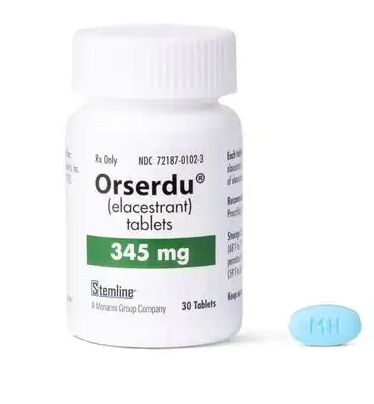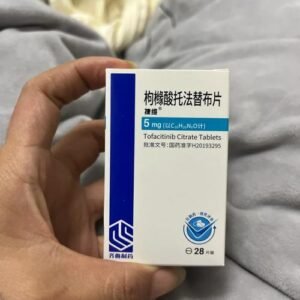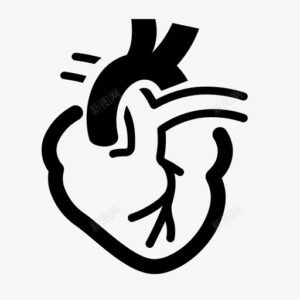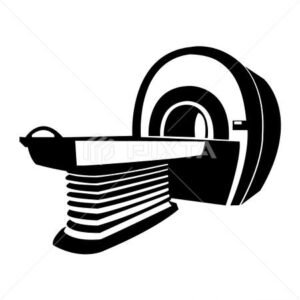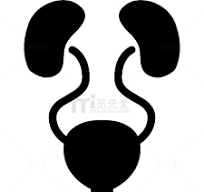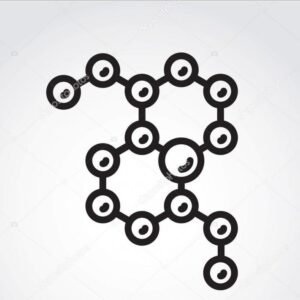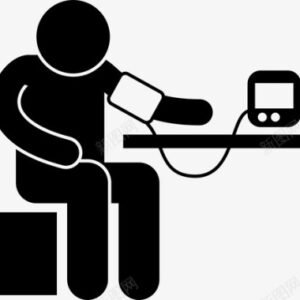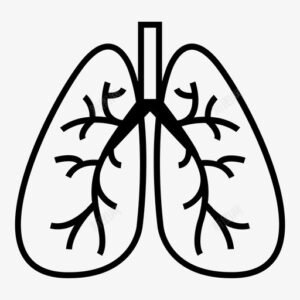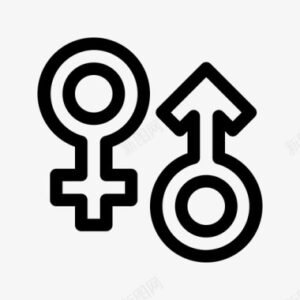ORSERDU ELACESTRANT 艾拉司群
Orserdu (elacestrant) indications
Orserdu is indicated for the treatment of postmenopausal women or adult men with advanced or metastatic breast cancer that is estrogen receptor (ER)-positive, human epidermal growth factor receptor 2 (HER2)-negative, and ESR1-mutated, who have progressed after at least one endocrine therapy.
Orserdu (elacestrant) specifications
Tablets: 345mg and 86mg
Orserdu (elacestrant) dosage and administration
The recommended dose of Orserdu is 345mg, taken orally once daily with food until disease progression or unacceptable toxicity occurs.
Take Orserdu at approximately the same time each day with food to reduce nausea and vomiting.
Swallow Orserdu tablets whole and do not chew, crush, or split the tablet before swallowing. Do not take any Orserdu tablets that are broken, cracked, or appear broken.
If a dose is missed for more than 6 hours or vomiting occurs, skip that dose and take the next dose at the normal time the next day.
Contraindications of Orserdu (elacestrant)
None
Orserdu (elacestrant) Mechanism of Action
Elacestrant is an estrogen receptor antagonist that binds to estrogen receptor alpha (ERα). In ER-positive (ER+) HER2-negative (HER2-) breast cancer cells, elacestrant inhibits 17β-estradiol-mediated cell proliferation and its concentration induces ERα protein degradation mediated by the proteasome pathway. Elacestrant demonstrated antitumor activity in vitro and in vivo, including ER+ HER2- breast cancer models resistant to fulvestrant and cyclin-dependent kinase 4/6 inhibitors and breast cancer models containing estrogen receptor 1 gene (ESR1) mutations.
Orserdu (elacestrant) Storage
Store at 20℃ to 25℃, with excursions to 15℃ to 30℃ allowed.
Orserdu (elacestrant) Precautions
I. Dyslipidemia
The incidence of hypercholesterolemia and hypertriglyceridemia in patients taking Orserdu was 30% and 27%, respectively. The incidence of grade 3 and 4 hypercholesterolemia and hypertriglyceridemia was 0.9% and 2.2%, respectively. Monitor blood lipids before starting and regularly during Orserdu.
2. Embryo-fetal toxicity
Based on the results of animal studies and its mechanism of action, Orserdu can cause harm to the fetus when administered to pregnant women. When maternal exposure is lower than the recommended dose based on the area under the curve (AUC), administration of elacestrant to pregnant mice can lead to adverse developmental outcomes, including embryo-fetal death and structural abnormalities.
Inform pregnant women and women of reproductive potential of the potential risks of drugs to the fetus. Women of reproductive potential are advised to use effective contraception during treatment with Orserdu and for 1 week after the last dose. Male patients with female partners of reproductive potential are advised to use effective contraception during treatment with Orserdu and for 1 week after the last dose.
Orserdu (elacestrant) adverse reactions
1. Orserdu may cause serious side effects, including: increased levels of fat (lipids) in the blood (hypercholesterolemia and hypertriglyceridemia). Your doctor will do blood tests before and during your treatment with Orserdu to check your lipid levels.
2. The most common side effects of Orserdu include: muscle and joint (musculoskeletal) pain; abnormal kidney function; nausea; decreased appetite; increased cholesterol and triglyceride levels; diarrhea; headache; abnormal liver function; constipation; fatigue; stomach (abdomen) pain; decreased red blood cell count; hot flashes; vomiting; indigestion or heartburn; decreased salt (sodium) levels in the blood.
3. Orserdu may affect the fertility of men and women who are able to become pregnant.
The most common (>10%) adverse reactions of ORSERDU, including laboratory abnormalities, include musculoskeletal pain, nausea, increased cholesterol, increased AST, increased triglycerides, fatigue, decreased hemoglobin, vomiting, increased ALT, decreased sodium, increased creatinine, decreased appetite, diarrhea, headache, constipation, abdominal pain, hot flashes, and indigestion.
Share:
Products
Our offers
Health Classification
Let us work together to protect precious health

